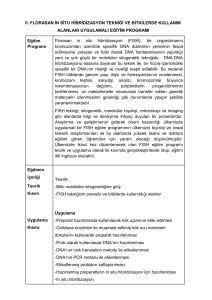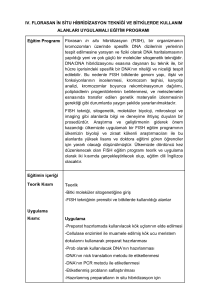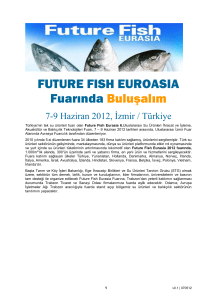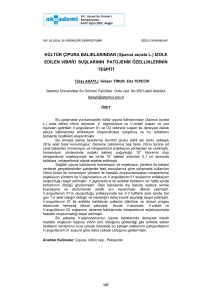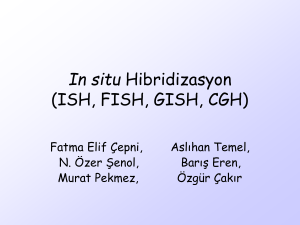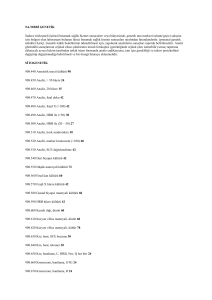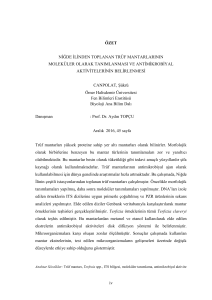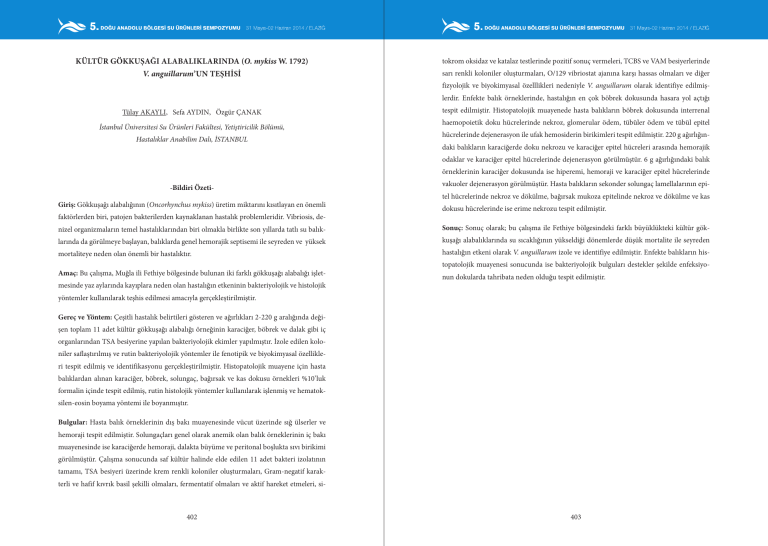
KÜLTÜR GÖKKUŞAĞI ALABALIKLARINDA (O. mykiss W. 1792)
V. anguillarum’UN TEŞHİSİ
tokrom oksidaz ve katalaz testlerinde pozitif sonuç vermeleri, TCBS ve VAM besiyerlerinde
sarı renkli koloniler oluşturmaları, O/129 vibriostat ajanına karşı hassas olmaları ve diğer
fizyolojik ve biyokimyasal özelllikleri nedeniyle V. anguillarum olarak identifiye edilmişlerdir. Enfekte balık örneklerinde, hastalığın en çok böbrek dokusunda hasara yol açtığı
Tülay AKAYLI, Sefa AYDIN, Özgür ÇANAK
İstanbul Üniversitesi Su Ürünleri Fakültesi, Yetiştiricilik Bölümü,
Hastalıklar Anabilim Dalı, İSTANBUL
tespit edilmiştir. Histopatolojik muayenede hasta balıkların böbrek dokusunda interrenal
haemopoietik doku hücrelerinde nekroz, glomerular ödem, tübüler ödem ve tübül epitel
hücrelerinde dejenerasyon ile ufak hemosiderin birikimleri tespit edilmiştir. 220 g ağırlığındaki balıkların karaciğerde doku nekrozu ve karaciğer epitel hücreleri arasında hemorajik
odaklar ve karaciğer epitel hücrelerinde dejenerasyon görülmüştür. 6 g ağırlığındaki balık
örneklerinin karaciğer dokusunda ise hiperemi, hemoraji ve karaciğer epitel hücrelerinde
-Bildiri ÖzetiGiriş: Gökkuşağı alabalığının (Oncorhynchus mykiss) üretim miktarını kısıtlayan en önemli
faktörlerden biri, patojen bakterilerden kaynaklanan hastalık problemleridir. Vibriosis, de-
vakuoler dejenerasyon görülmüştür. Hasta balıkların sekonder solungaç lamellalarının epitel hücrelerinde nekroz ve dökülme, bağırsak mukoza epitelinde nekroz ve dökülme ve kas
dokusu hücrelerinde ise erime nekrozu tespit edilmiştir.
nizel organizmaların temel hastalıklarından biri olmakla birlikte son yıllarda tatlı su balık-
Sonuç: Sonuç olarak; bu çalışma ile Fethiye bölgesindeki farklı büyüklükteki kültür gök-
larında da görülmeye başlayan, balıklarda genel hemorajik septisemi ile seyreden ve yüksek
kuşağı alabalıklarında su sıcaklığının yükseldiği dönemlerde düşük mortalite ile seyreden
mortaliteye neden olan önemli bir hastalıktır.
hastalığın etkeni olarak V. anguillarum izole ve identifiye edilmiştir. Enfekte balıkların his-
Amaç: Bu çalışma, Muğla ili Fethiye bölgesinde bulunan iki farklı gökkuşağı alabalığı işletmesinde yaz aylarında kayıplara neden olan hastalığın etkeninin bakteriyolojik ve histolojik
topatolojik muayenesi sonucunda ise bakteriyolojik bulguları destekler şekilde enfeksiyonun dokularda tahribata neden olduğu tespit edilmiştir.
yöntemler kullanılarak teşhis edilmesi amacıyla gerçekleştirilmiştir.
Gereç ve Yöntem: Çeşitli hastalık belirtileri gösteren ve ağırlıkları 2-220 g aralığında değişen toplam 11 adet kültür gökkuşağı alabalığı örneğinin karaciğer, böbrek ve dalak gibi iç
organlarından TSA besiyerine yapılan bakteriyolojik ekimler yapılmıştır. İzole edilen koloniler saflaştırılmış ve rutin bakteriyolojik yöntemler ile fenotipik ve biyokimyasal özellikleri tespit edilmiş ve identifikasyonu gerçekleştirilmiştir. Histopatolojik muayene için hasta
balıklardan alınan karaciğer, böbrek, solungaç, bağırsak ve kas dokusu örnekleri %10’luk
formalin içinde tespit edilmiş, rutin histolojik yöntemler kullanılarak işlenmiş ve hematoksilen-eosin boyama yöntemi ile boyanmıştır.
Bulgular: Hasta balık örneklerinin dış bakı muayenesinde vücut üzerinde sığ ülserler ve
hemoraji tespit edilmiştir. Solungaçları genel olarak anemik olan balık örneklerinin iç bakı
muayenesinde ise karaciğerde hemoraji, dalakta büyüme ve peritonal boşlukta sıvı birikimi
görülmüştür. Çalışma sonucunda saf kültür halinde elde edilen 11 adet bakteri izolatının
tamamı, TSA besiyeri üzerinde krem renkli koloniler oluşturmaları, Gram-negatif karakterli ve hafif kıvrık basil şekilli olmaları, fermentatif olmaları ve aktif hareket etmeleri, si-
402
403
DIAGNOSIS OF V. anguillarum IN CULTURED RAINBOW TROUT
(O. mykiss W. 1792)
and actively motile, giving positive results in oxidase and catalase tests, forming yellow
colonies on TCBS and VAM, being sensitive to O/129 vibriostatic agent and depending on
other physiological and biochemical characteristics. In the histopathological examination
of the infected fish samples, it was detected that the disease has affected the kidney tissue
Tülay AKAYLI, Sefa AYDIN, Özgür ÇANAK
İstanbul Üniversitesi Su Ürünleri Fakültesi, Yetiştiricilik Bölümü,
Hastalıklar Anabilim Dalı, İSTANBUL
primarily. In the histopathological examination, necrosis of the interrenal haemopoietic
cells, glomerular edema, tubular edema, degeneration in the tubule epithelium cells and
small hemosiderin accumulations were detected in the kidney tissue. In the histopathological
examination of the liver tissue of 220 g samples, necrosis, hemorrhagic centers among
liver epithelium cells and degeneration of the liver epithelium cells were detected. In the
histopathological examination of the liver of 6 g samples, hyperemia, hemorrhages and
-AbstractIntroduction: One of the most important limiting factors of rainbow trout (Oncorhynchus
mykiss) production is disease problems caused by pathogenic bacteria. Vibriosis is among
the main diseases of marine organisms which progresses with general hemorrhagic
vacuolar degeneration in the liver epithelium cells were detected. Besides, necrosis of the
epithelium cells of the secondary lamellae in the gills, necrosis and depletion of the gut
mucosal epithelium and liquefactive necrosis in the muscle tissue cells were detected in the
infected fish samples.
septicemia in fish and causes mortalities, but also it has been observed in freshwater fish
Conclusion: In conclusion, in this study, V. anguillarum was isolated and identified as the
species in recent years.
causative agent of the disease problem which affects cultured rainbow trout in different sizes
Aim: This study was carried out for the diagnosis of the etiological agent of the disease
which causes mortalities in two different rainbow trout farms in Fethiye – Muğla in summer
months, by using bacteriological and histological methods.
and causes low mortality rates in the periods that the water temperature has risen. As a
result of the histopathological examination of the infected fish samples, it was detected that
the disease caused severe destruction in the tissues of infected fish samples and this result
supports the bacteriological findings.
Material and Methods: Bacterial inoculations were made onto TSA from the internal
organs such as liver, kidney and spleen of a total of 11 rainbow trout samples weighing
between 2-220 g which showed various clinical signs of the disease. Isolated colonies
were sub-cultured and their phenotypic and biochemical properties were determined by
using routine bacteriological methods and later they were identified. Liver, kidney, gill,
intestine and muscle tissue samples taken from the moribund fish samples were fixed in
10% formaldehyde, processed by using conventional histological methods and stained with
haemotoxylin-eosin method for histopathological examination.
Result: In the external examination of the moribund fish samples, shallow ulcers and
hemorrhages were detected on the body surface. In the internal examination of the moribund
fish samples that have anemic gills in general, hemorrhages on the liver, spleenomegaly and
accumulation of a fluid in the peritoneal cavity were observed. As a result of the study, 11
bacterial isolates were identified as V. anguillarum because of forming cream colored colonies
on TSA, being Gram-negative and slightly curved basil shaped bacteria, being fermentative
404
405


